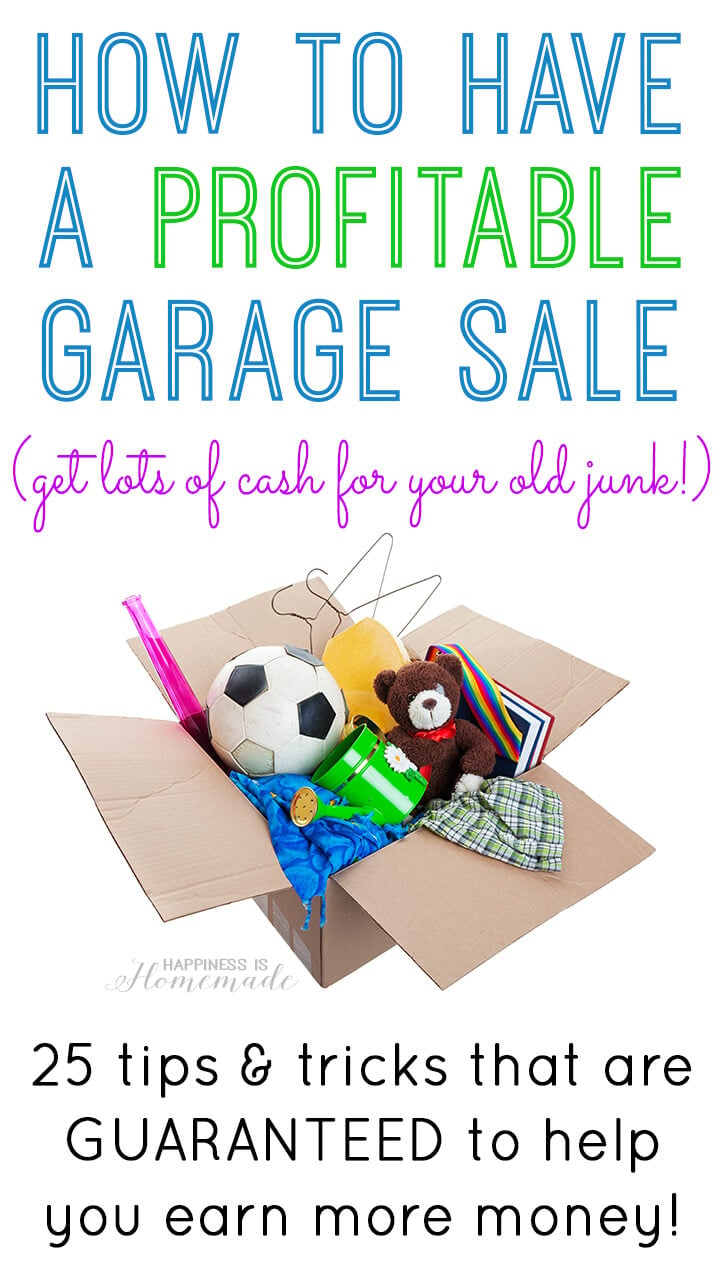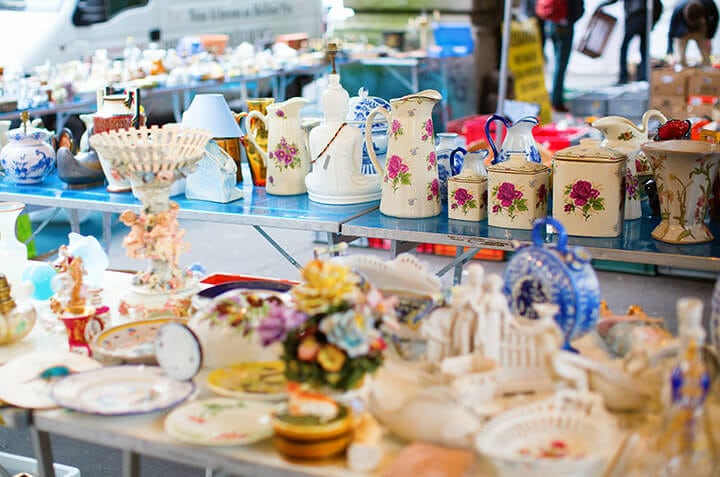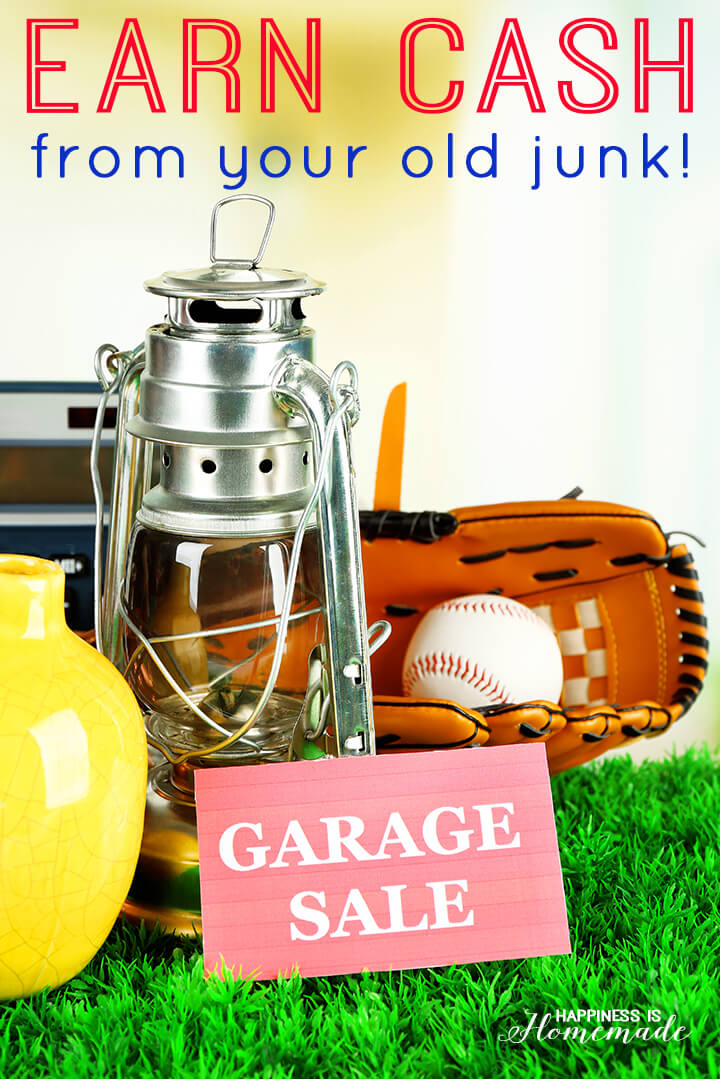25 “How to Have a Garage Sale” tips and tricks that are guaranteed to help you throw a successful yard sale, and make a ton of money selling your old stuff!
‘Tis the season for yard sales (or garage sales, rummage sales, tag sales…whatever you call them in your neck of the woods!)! Have lots of stuff that you don’t use anymore? Is it just laying around your house or taking up precious garage space? Need some extra cash? Throw your very own garage sale and turn your old “junk” into money!
Each year we participate in our community’s annual sale, and since there are over 200 homes that join in each year, it’s a natural traffic-driver. Having a community or neighborhood-wide sale is a fantastic way to bring traffic to an area that may not normally get very much traffic. Advertising that there is a TON of stuff for sale from multiple families always draws a larger crowd!
Since we have a lot of garage sale experience, we’ve learned a few lessons and picked up a few tips and tricks along the way that I am going to share with you today. The biggest lesson that I’ve learned is that a prepared and organized garage sale will result in the most profitability, and if you follow the tips below, you’re sure to bring in more cash at your next garage sale, too!
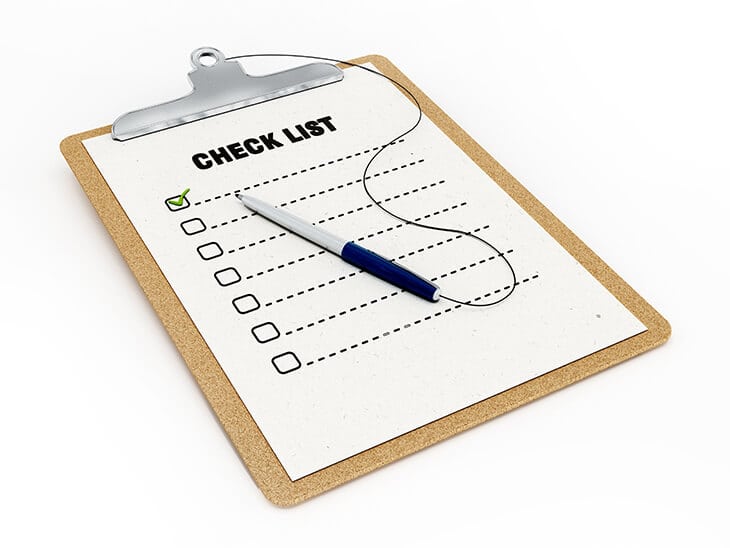 Pre-Planning for Your Yard Sale:
Pre-Planning for Your Yard Sale:
- Choose your yard sale date wisely. Popular months for yard sales are April, May, June and September. Saturdays seem to be the most profitable days for a sale – pick one that falls soon after the 1st or the 15th of the month when many people get paid.
- Make an inventory list of everything that you want to sell in advance. (This will help ensure that you don’t find a bunch of stuff in your garage the weekend following your sale, and say, “Oh darn! I meant to put those out!”)
- Give yourself plenty of time to gather and price your sale items. You don’t want to pull an all-nighter right before your sale. Save your energy! You’ll need it.
- Advertise your sale. Post your sale on Craigslist for free, or put an ad in the local paper along with a highlight of the items you’ll be selling. List the time frame of your sale! Our sales generally run from 7 am – 3 pm, but be prepared for “early birds” to start showing up to your sale as early as 5am. Even if you state “no early birds” in your ad, they’ll show up anyway, especially if they think you have a large selection of items for sale.
- Use signage to direct traffic. Brightly colored posters with large, bold text will show up a lot better than ballpoint pen on a piece of tan card board. Make sure you can clearly read your signs! Use basic signs with “Garage Sale,” large directional arrows and the dates on the signs that are directing people into your neighborhood, and then (if desired) throw in a little bit of humor as they get close to your sale location. Since we participate in a community-wide sale, most drivers recognize that it’s garage sale day, and our funny signs help us stand out in the sea of signage.
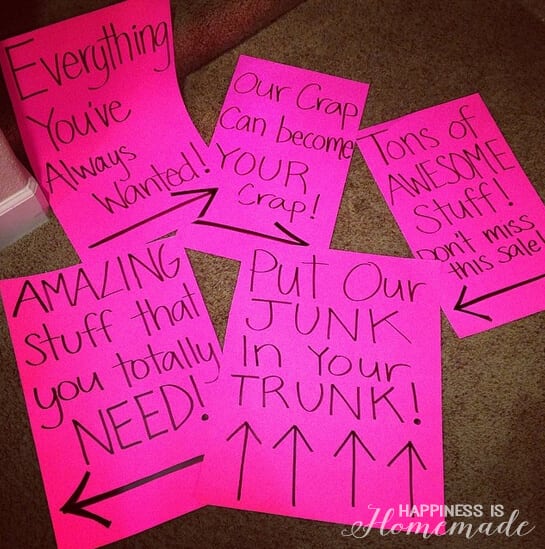 These are the signs that we used to lead directly into our sale location. They worked! Everyone commented that they felt compelled to follow the silly signs to check us out!
These are the signs that we used to lead directly into our sale location. They worked! Everyone commented that they felt compelled to follow the silly signs to check us out!
Pricing Your Items:
- When pricing your items, keep two things in mind. 1) Are you looking to get top dollar for your merchandise or 2) Are you looking to just get rid of it? Identify prices on items that are non-negotiable (if they don’t sell at your yard sale, you can post them on eBay or Craigslist). If you dread the idea of packing up your items and storing them again, price them to sell! You are more likely to sell an item with a low price, and the lower your prices are, the more that people tend to buy from you!
- Do your research. When pricing items, be sure to know what the going rate is for that particular toy, appliance, piece of furniture, etc. Ask friends and family what they’d be willing to pay, and check out eBay and Craigslist to see how much similar items are selling for.
- Most yard sellers price their items at 10-20% of what they originally paid for it. Price your items slightly above what you’d accept so that you have room for negotiation. For example, if I originally paid $20 for an item, I would set the price between $2.50 to $5 in the hopes that I would receive from $2-4 for it. Keep in mind the condition of the item for sale, how much life it still has left in, and how rare/common the item is. Used clothing tends to bring in a smaller return on investment, and I price almost all of my clothing at $.50 to $3 maximum.
- Keep math to a minimum. Don’t price items for $.10 or $0.75. We stick with $.50 increments so that no calculators are necessary (they just slow down your checkout line!).
Setting Up, Organizing, and Displaying Sale Items:
- Make sure to have enough table space to display your sale items. We make large temporary tables with sheets of plywood and sawhorses and cover them with plastic tablecloths.
- Keep as many items as possible off of the ground! Customers don’t want to get down on their hands and knees to rummage through piles of clothing or other items. Some customers may not be physically able to get down to get a closer look at your items. You will sell a lot more if people can easily access it!
- Be organized. One recurring compliment that we always hear from our customers is how organized we are. When pricing our clothing items, I use a small piece of masking tape to write the size and price on the garment. I place that label in the center of each item so that it is highly visible. When we display our items for sale, I try to organize the clothing in sections by size as much as possible. This directs people to the proper area, and the prominent size stickers keep them from tearing apart our nicely folded display.
- Take your items out of the box. People are visual creatures – if they can’t see what you’re selling, they’re going to pass you up. Display items so that people can easily see the details. Place books in a bookcase (you can make a temporary “bookcase” with cardboard boxes!), set out shoes so that they can easily be tried on, and package small items in clear plastic zipper bags. An inexpensive garment rack for hanging clothing items is worth it’s weight in gold!
- Group Similar Items Together. Treat your garage sale like a store, and set up a pretty display! Group like items together so that shoppers can quickly locate things. After you’ve sold a few things and the tables are beginning to looking bare, consolidate items and rearrange them to keep up the “shop appearance” of your sale.
- Entice male buyers by setting out tools, electronics, and yard equipment near the front half of your property. Husbands will often wait in the car while their wives peruse the sale, but if they see stuff that interests them up front and center, they’re more likely to park, get out, and shop, too!
The Day of Your Sale:
- Have lots of change on hand. We like to start with $25 in ones, $30 in fives, $40 in tens, and $5 in quarters ($100 total). It’s better to have too much change than not enough! People are often looking to break their large bills first thing in the morning, and you don’t want to be short if someone wants to purchase $2 worth of items, but they only have a $20 bill. (Trust me, it happens A LOT.)
- Make sure to have at least two people running the sale at all times. That way when one person is handling a sale, the other can keep an eye on everything else and answer any questions that shoppers may have. Unfortunately, not only do yard sales bring out shoppers, but they also bring out shoplifters, so it’s best to have two pairs of eyes on things at all times.
- Keep your money close! If you’re using a cash box, be sure that someone is sitting with it at all times! If that’s not possible, consider wearing the cash on you. Use a waist pack or a small purse across your chest so that your money will never be left unattended.
- As the day goes on, you’ll find yourself accumulating more money than you need to have on-hand for making change. Every so often, pull out large bills like $20’s and $10’s from your earnings and stash them away inside your house.
- Play a little background music. We always have music playing after 8:30 am (once everyone has had a chance to wake up a little bit!). This helps eliminate any awkward silence and makes people feel comfortable cruising through your yard. We play classic rock because our shoppers respond really well to it, but whatever you play, just make sure it’s not offensive or aggressive. You want to set the tone of an upbeat and relaxed atmosphere, so choose music that works for the situation.
- Make sure to have extra bags and empty boxes on hand for people to pack their purchased goods (remember, your super low prices are going to make them want to buy a lot of things from you!). I re-use all of my plastic grocery store bags at our garage sales!
- As you near the end of your day, consider slashing prices, offering two-for-one deals, or marking some items that you never want to see again as “free.” That way you won’t be stuck repacking and re-storing your leftover items later!
Other Tips to Remember:
- Wear sunscreen. Even if it’s overcast outside, you’ll be outside for most of the day, so keep your skin protected with SPF and a hat.
- Drink lots of water, and keep snacks handy. Just when you think that it’s safe to take a lunch break, a mass of shoppers will pull up! Be prepared with snacks and water, and then take turns with your sale partner for a quick lunch break when there’s a lull in the traffic.
- When in doubt, just set it out! You never know what people are looking to buy! I have sold many, many items that I was sure would NEVER sell. There’s plenty of truth behind the saying “one man’s trash is another man’s treasure!”
Good luck!

Heidi Kundin has captivated the hearts of millions with her colorful and inspiring approach to crafting, celebrations, and family fun. With over 15 years of experience, Happiness is Homemade has become a must-visit destination for those seeking quick and easy creative ideas and last-minute solutions. Heidi’s warm personality shines through her posts, inviting readers to join her on a creative journey that’s fun, rewarding, and achievable. Heidi is also the author of Homemade Bath Bombs & More and DIY Tie-Dye.

